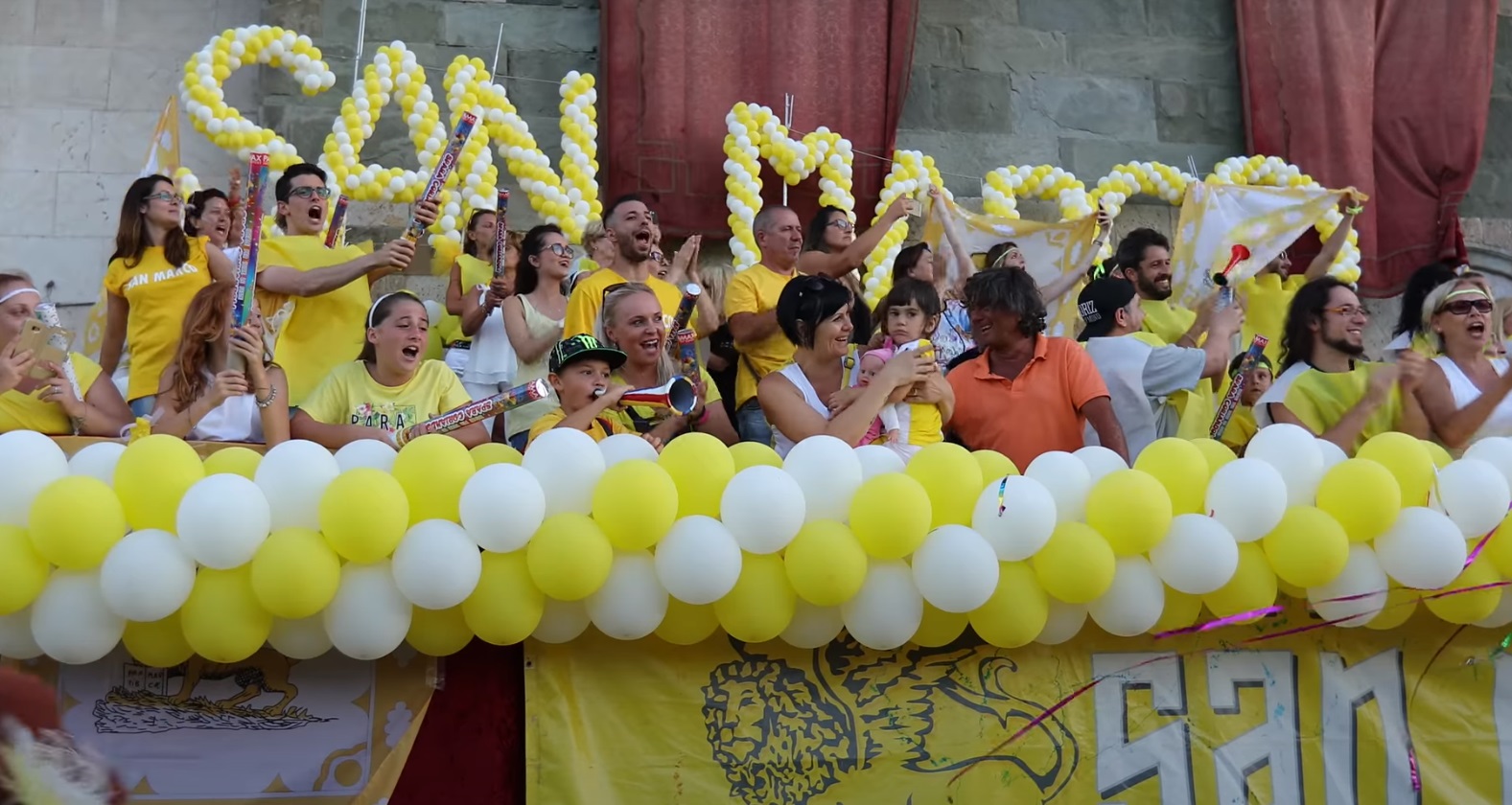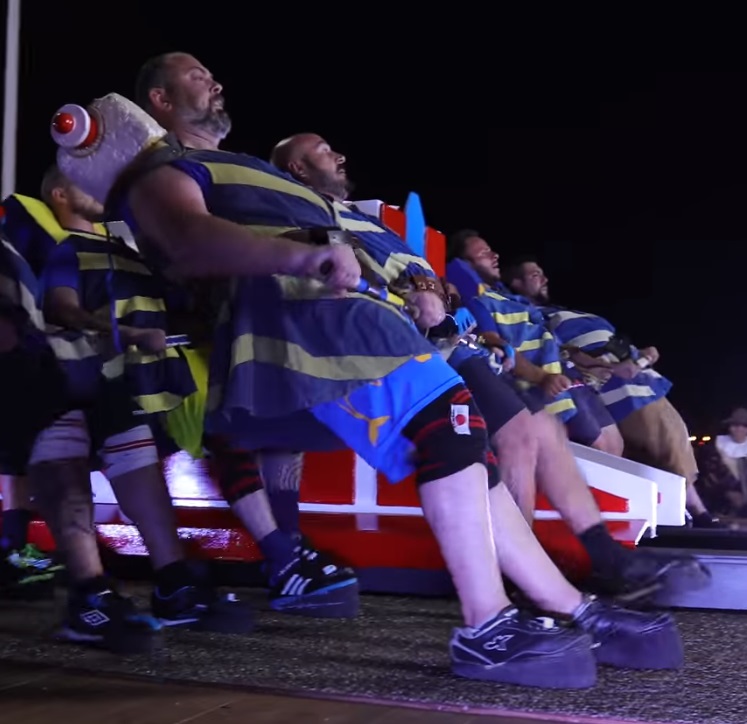Gioco Del Ponte – Battle of the Bridge
Imagine 20 men having a tug-of-war, but in reverse – a “push-of-war”. This is what comes to mind when I think of the Gioco Del Ponte festival in Pisa, Italy. This yearly fun and crazy event pits men against each other in a test of brute strength as the two teams try to push a multi-ton sled to the other side of the bridge. The result is about 10 minutes (usually) of grunting and sweating as the sled slowly moves from the middle of the bridge to one side.
History
To understand why this festival even exists, we need to look at the history. We don’t know for sure how the game began, but historians have a pretty good guess. In the 11th century, many cities in Tuscany and Umbria had armies that would train for battle with a game called Mazzascudo. The names comes from the Italian words for club, “mazza”, and shield “scudo”, and was basically a duel between two competitors using clubs and shields.
No sport is worthwhile without a competition, so a yearly Mazzascudo tournament was often held with individual battles. At the end of several days of the one-on-one contests, the participants would break into 2 groups, the Gallo and the Gazza, and would engage in a free-for-all with roughly 50 people per side.
In the version enjoyed in Pisa, the combatants were known to practice in the Piaza dei Cavaliere, which is near the Ponte di Mezzo where the games are held today. Each team would begin on their side of the Ponte Vecchio bridge (the Ponte Vecchio bridge was destroyed in WWI and rebuilt as Ponte di Mezzo) and try to gain possession of the opposite side by any means necessary. In the original games each side would build a “castle” (a wooden fort) on their side and the objective was first to defend your own castle, and second to seize the opponents’.
The Old Rules
The rules of engagement were few. Each team was allowed to capture opposing players and drag them back to their own castle as prisoners. The teams often fought in phalanxes and had elaborate strategies for offense and defense, including sometimes building a fake decoy castle they would leave relatively unguarded in the hopes the other team would fall into a trap. Each team was allowed to substitute 6 men at a time but only every 2 minutes. For each man that went in one had to come out, so losing men to capture was a big concern.
The battles would rage for 45 minutes at which time, if neither side was yet victorious, both sides were to drop strategic maneuvers in favor of a mad free-for-all on the bridge until someone captured the other castle.
Enter the Medici Era
Flash forward to the Medici era in the 16th century. The first recorded contest happened on February 22, 1568, on the Ponte Vecchio. It was held sporadically through the years until 1785 when Pietro Leopoldo shut it down. At the time Pisa was under the rule of Florence, and Pisans were not very happy about this. Pietro Leopoldo thought the games brought out too much Pisan nationality and aggression against the Florencian captors, so he stopped the games.
Though the games were held once in 1807, they didn’t reappear repeatedly until 1935. As the games regained their popularity, the clubs and shields were left behind in favor of the pushing contest we have today. Though the 20th century has seen the games fairly often, they were not brought back to a regular yearly schedule until 1982.
Exactly What Is The Gioco Del Ponte?
So what exactly is the Gioco Del Ponte? Well, as I said at the beginning, it’s like a reverse tug-of-war. A multi-ton specially constructed iron sled is placed in the middle of the Ponte di Mezzo. One team from the northern side of the bridge, the Tramontana, competes against the team from the south side, the Mezzagiorno.
The Teams
Each of these teams has 6 squads of 20 men called Magistracies, where each squad represents a different neighborhood on their side of the bridge. These squads are matched up with one from the north and one from the south, then try to push the sled to the other side of the bridge. The team that gets 4 victories wins and gets bragging rights for the rest of the year, so there is a lot of support in the crowd for the different teams.

Updated Rules
If the 6 “regular season” competitions end in a 3-3 tie (called “la bella”), there is a final round that decides the winner. Ties happen frequently, so through the years they have experimented with different tie breaker events. It started with a winner-take-all final push where each team picked their best Magistrace (no member substitutions allowed). That gave way from 1997 to 2000 to just letting the tie stand. In 2001 they tried merging one of the 6 Magistracies into the other 5 and doing the whole thing again, but they finally decided on the final tie breaker made up of a special Magistrace chosen from among all the 120 members with enough energy left to participate.
There are some special rules that must be observed. The members of the team can only push with their shoulders and neck.

Also, the track the sled is on is slightly inclined at both ends making the task slightly more difficult for both teams. The men are allowed to use special shoes where the toe is higher than the heel, making the pushing easier. They are also allowed to put a pillow between their shoulders and the hard foam of the sled.

How Does It Work?
As the match starts, the sled has the brakes on while the teams get into position. Each team has the competitors and their coach, so when both coaches give the signal they are ready, the referee fires a starter pistol and releases the brake.
These matches can be long, grueling efforts or quick and painful. They typically last from 4 to 8 minutes, but there are extremes like a match that lasted 43 seconds, and another that went a devastating 23 minutes. If you want to know how long the matches last, you can find a full record here.
Here is an excellent YouTube video showing the competition and parade.
Itinerary for the Full Event
Aside from the competition itself, the day provides many diversions. The festivities start with a parade, which is a glorious site to see. All the competitors arrive in their 16th century Spanish military garb, with their ceremonial clubs, ready to do battle.

Gioco Del Ponte Competitor
The two teams each follow the same circular parade route, but on opposite sides so you can see everything from a single vantage point. Each team has exactly 312 participants including the combatants and the leaders, and they are all dressed in glorious period costumes. There is also a third parade going on at the same time, made up of the 81 judges for the contest.

Gioco Del Ponte Drummers and Judges
The official 5 phases are
- Parade of troops along the Lungarni river.
- Formal battle opening ceremony by the Anziano Rettore
- A call to arms for all the competitors
- The ambassadors of the Mezzagiorno and Tramontana teams will make official challenges to each other on horseback
- The competition begins.
Logistics
There are tickets sale if you want to sit in the grandstand, but it’s much more fun if you mingle with the Pisans on the side of the river where there is plenty of space and no reservations are necessary

The parade starts a bit late at 8PM and the competition starts at about 10PM so plan accordingly. I don’t advise driving to the event due to the throngs of people in the streets. The trains are excellent in Pisa (and all through Italy) so if you are coming from another city that is the best way to arrive. Either of the 2 stations in Pisa are walking distance from the bridge.
Though the games originally were held on the last Sunday of June, in 2009 this was switched to the last Saturday in June.








